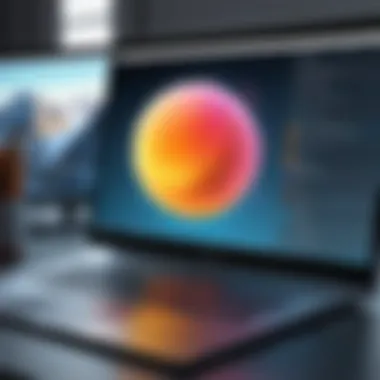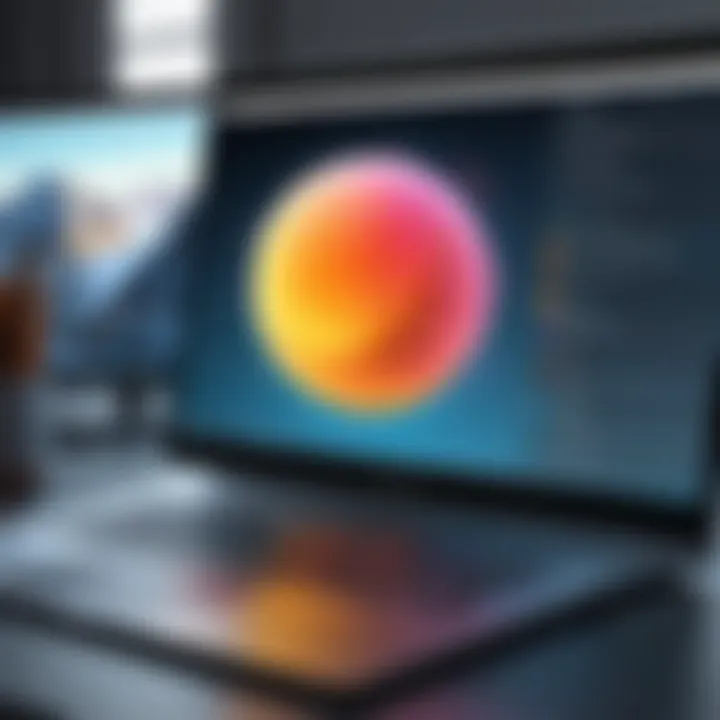A Guide to 3D Object Modeling Software in Various Industries


Intro
When we look at the digital landscape today, it’s staggering to realize how much 3D object modeling software has permeated various sectors. Say you’re playing the latest video game; those immersive worlds and intricate characters are crafted using this very technology. Go into an architectural firm, and you might find architects spinning virtual models of buildings before they even lay a brick. Spanning across gaming, architecture, and even education, these tools have reshaped how we visualize and interact with ideas and concepts.
Often overlooked are the underpinning technologies that make these tools so powerful. It's more than just lines and curves; it’s about the algorithms and hardware that allow creators to bring their imaginations to life. Whether you’re a small business owner seeking the right tools for your next project or a seasoned professional delving into new trends, understanding this domain is invaluable. In this guide, we will navigate through the major features, system requirements, and emerging trends surrounding 3D modeling software.
With every click and every render, these programs not only enhance creativity but also drive efficiencies in processes, ultimately contributing to the success of ventures, large or small. So, buckle up, as we embark on this comprehensive journey into the world of 3D modeling tools.
Brief Description
Overview of the software
3D object modeling software is designed to create digital replicas of physical objects or imaginary creations. They enable users to craft everything from realistic human figures to abstract art. These programs come equipped with various specialized tools that facilitate the modeling, texturing, and rendering processes.
Key features and functionalities
Among the many features one can expect from top-tier software in this field are:
- Intuitive User Interface: A user-friendly workspace that allows users of all skill levels to navigate easily.
- Advanced Rendering Capabilities: High-quality lighting and shadow simulations to make objects look real.
- Texturing Options: A wide range of textures to apply to models for added realism.
- Sculpting Tools: Options that allow the user to manipulate objects lik they were made from clay.
- Animation Support: Features that enable the user to bring models to life through movement.
This software is applicable across various fields, making it an essential tool in technology-driven environments.
System Requirements
When considering the right software, be mindful of the hardware and software you’ll need.
Hardware requirements
For optimal performance, many programs call for:
- CPU: A powerful processor, preferably multi-core.
- GPU: A dedicated graphics card to manage rendering. For instance, cards like NVIDIA GeForce RTX or AMD Radeon often take the limelight.
- RAM: At least 16GB is recommended, but 32GB or more is better for larger projects.
- Storage: SSD drives have proven to be much faster than traditional hard drives, enhancing load times.
Software compatibility
Most modeling software runs on both Windows and macOS, but it's crucial to check compatibility with specific operating systems. Some may also require additional frameworks or libraries installed, like .NET or OpenGL. Always refer to the software’s official website to ensure that your system meets the necessary requirements before committing.
In the world of 3D modeling, investing in good hardware parallels investing in quality tools: both lay the foundation for creating impressive output.
This guide will further explore the tools available, workflows to optimize productivity, and emerging trends that could shape the future of 3D modeling. Get ready to dive deeper into the specific applications and selections available today.
Intro to 3D Object Modeling Software
In the modern landscape, where visual representation often trumps textual explanation, 3D object modeling software stands as a cornerstone for numerous industries. The importance of these tools can't be overstated—their ability to create virtual objects that mirror real-life counterparts fascinates and facilitates varied applications, from gaming to architecture.
Understanding 3D Modeling
At its core, 3D modeling involves the creation of a mathematical representation of a three-dimensional object. Imagine crafting a clay model but in a digital format that can be manipulated, colored, and animated. 3D modeling transforms abstract ideas into tangible representations. The resulting models can be examined from any angle, allowing for immersive experiences that traditional 2D representations simply can't offer.
Key benefits of 3D modeling include:
- Enhanced visualization of concepts
- The ability to iterate designs quickly
- Improved communication among team members
Professionals working in fields such as product design or architectural visualization can illustrate their visions through more compelling presentations of their ideas.
Historical Context
To appreciate where we are today, it’s crucial to delve into the historical context of 3D modeling. The journey began in the late 1960s with the introduction of computer graphics. Early models were simplistic, often made of simple geometric shapes. Yet, as technology progressed, so did the complexity of the software.
The 1990s were a pivotal period, heralding the emergence of software like AutoCAD and 3D Studio Max, providing professionals with the ability to create more intricate designs. What once took weeks of labor could now be accomplished in a fraction of the time.
Over the decades, advancements in computing power and rendering techniques have made 3D modeling software increasingly accessible to various sectors. Today, it’s commonplace to find tools that allow nearly anyone, from small businesses to large corporations, to bring their ideas to life in three dimensions.
"3D modeling has evolved from a cumbersome process to a fluid, dynamic practice, democratizing access for creators across the board."
This historical insight helps contextualize the software's significance today, revealing how it shapes potential futures across industries.
Understanding 3D modeling and its historical background is crucial for anyone looking to harness its capabilities effectively. As we delve deeper into the mechanics and applications of these tools, this foundational knowledge will serve as a beacon for effective usage and innovation.
Key Technologies Behind 3D Modeling
The world of 3D modeling is shaped by various core technologies. These technologies form the backbone that drives creativity and innovation in industries like gaming, film, industrial design, and architecture. Understanding them is not just useful; it's crucial for anyone involved in the 3D graphics field. This section will explore the fundamental advancements that underpin 3D modeling techniques, focusing specifically on polygonal modeling, NURBS, and sculpting methods.
Polygonal Modeling Techniques
Polygonal modeling is one of the oldest yet most prevalent methods of creating 3D objects. At its core, this technique involves constructing shapes from polygons, typically triangles or quadrilaterals. Each polygon forms a facet of a 3D model. The beauty of polygonal modeling lies in its versatility and the ability for artists to refine complex forms with relative ease.
Importantly, polygonal modeling is favored in real-time applications like computer games due to its lightweight structure that maintains performance. However, the approach also comes with its share of challenges. Artists must be meticulous about managing the vertex count and ensuring that the model remains good for texture mapping.
Some common workflows involve:


- Box Modeling: Starting with a primitive shape and gradually shaping it into more complex forms.
- Edge Modeling: Adding detail by manipulating edges and vertices of existing polygons.
- Retopology: Restructuring a high-density model into a much cleaner version, which is vital for faster rendering.
"Polygonal modeling allows artists to create functionally and aesthetically compelling assets for diverse applications."
NURBS and Curve-Based Modeling
When it comes to producing smooth and flowing shapes, NURBS (Non-Uniform Rational B-Splines) are often the go-to choice. This technology is pivotal for industries where precision is key, such as automotive and aerospace design. NURBS models are defined mathematically using control points, allowing for a level of smoothness that polygonal models can't easily achieve.
The great advantage of NURBS is their adaptability. Artists can reshape the curves and control points without sacrificing the overall integrity of the design. This is particularly useful in scenarios where organic forms are required. Still, NURBS has its drawbacks, such as a steeper learning curve and compatibility issues with certain rendering engines.
- Benefits of NURBS include:
- Considerations involve:
- High precision and smoothness.
- Ease of making alterations without significant rework.
- More complex for beginners.
- Mostly applicable to specific industries rather than general 3D modeling.
Sculpting and Freeform Techniques
In recent years, digital sculpting has revolutionized the way 3D artists work. Sculpture software like ZBrush or Mudbox allows creators to manipulate models like they would clay. This approach provides the freedom to explore finer details and organic shapes, which is particularly favored in character design for films and video games.
Sculpting offers a tactile and intuitive workflow. You can push, pull, pinch, and smooth the surface just like a traditional sculptor. This hands-on method fosters creativity but can also lead to pitfalls, including overly complex mesh that becomes difficult to texture or animate later.
Key aspects of sculpting worth mentioning are:
- DynaMesh: A feature that allows for continuous reshaping without worrying about the base mesh's topology.
- ZRemesher: An automated tool that helps to create quad-based meshes from sculpted models, making them easier to work with for rigging and animation.
In summary, the key technologies behind 3D modeling—polygonal, NURBS, and sculpting—each offer unique benefits and challenges. Familiarity with these methods can help professionals select the most effective approach for any given project, impacting both creative outcomes and production efficiency.
Overview of Popular 3D Modeling Software
When diving into the waters of 3D object modeling, it’s essential to have a grasp of some of the mainstream software tools available today. Each software offers its own unique cocktail of features, workflows, and user experiences, making them more suitable for different tasks or industries. Even though various programs might share similarities, they each cater to distinct niches—be it gaming, architecture, or product design. Understanding these tools isn't just advantageous; it’s a vital component for professionals aiming to make informed decisions.
These applications serve as the backbone for many creative projects, enabling users to transform abstract ideas into tangible models that can be visualized and manipulated. The availability of robust software solutions means that regardless of your expertise level—from seasoned veterans to novices—there’s something for everyone.
Here are a few considerations to keep in mind when evaluating popular 3D modeling software:
- Ease of Use: Some programs have steep learning curves, while others boast user-friendly interfaces that ease the process of modeling.
- Feature Sets: The tools available within the software, such as sculpting tools, texture mapping options, and rendering capabilities, can greatly influence the quality of the final product.
- Integration: How well the software works with other platforms or plugins is often a crucial factor, especially when working on collaborative projects.
- Cost: Pricing structures vary greatly, from free and open-source options to premium licenses that can significantly impact budget considerations.
Understanding the options available is the first step in ensuring that the chosen software aligns well with the specific goals and requirements of your projects.
Blender
Blender stands out in the 3D modeling landscape as a versatile and feature-rich tool. It's an open-source software, which means it’s completely free, yet it doesn’t skimp on functionality. Users can engage in everything from basic modeling to advanced animation and texture painting—all under one roof. What makes Blender particularly attractive is its supportive community, which is abundant with tutorials, add-ons, and forums.
Some highlighted features of Blender include:
- Sculpting Tools: Advanced sculpting capabilities allow artists to create highly detailed models.
- Animation System: Blender includes an entire animation suite perfect for character rigging and animation.
- Real-Time Rendering: With its Eevee render engine, users can see their changes in real-time, speeding up the visual feedback loop.
Choosing Blender might not only save on software costs but also provide a pathway to mastering 3D modeling comprehensively.
Autodesk Maya
Autodesk Maya holds a prominent position, particularly in industries focused on animation and visual effects. It's well-known for its robust capabilities and wide-ranging applications, making it a staple among many high-profile studios and independent creators alike.
Maya is especially popular because of its:
- Robust Animation Features: Inherits excellent rigging and animation tools, ideal for character animation.
- Extensive Plugin Support: Easy extensions to functionality with numerous third-party plugins enhance its capabilities further.
- Industry Standards: Regularly used in large productions, familiarity with Maya can be beneficial if one aims to work in professional environments.
While it does come with a price tag, the investment is considered worthwhile if your goal centers around professional-level animation or film production.
SketchUp
SketchUp has carved out its niche primarily in architecture and interior design realms. It's acclaimed for its intuitive design approach and user-friendly interface, allowing users to unpack their creative ideas with relative ease. What puts SketchUp in a class of its own is its ability to simplify complex architectural models.
Key aspects include:
- 3D Warehouse: A vast database of pre-made models available for use right away, saving time in the design process.
- Real-Time Visualization: The immediate feedback from 3D visualizations helps in making on-the-go design alterations.
- Collaborative Features: Great options for sharing and collaboration keep teams connected during projects.
For those focused on design, SketchUp offers an abundant toolbox that keeps the modeling process engaging and straightforward.
Cinema 4D
Cinema 4D often steals the spotlight in sectors focused on motion graphics and visual effects. Known for its user-friendly interface and powerful capabilities, it has become one of the go-to solutions for creating dynamic visuals that can captivate the audience's attention.
Some appealing features include:
- Motion Graphics Toolset: A dedicated set of tools and functionalities tailored for creating top-notch animations.
- Procedural Workflows: The ability to create complex designs easily while maintaining flexibility throughout the modeling process.
- Great Integration with Adobe Products: Seamless syncing with Adobe After Effects makes it a preferred choice for many animators and motion graphic artists.
Cinema 4D may offer a steep learning curve initially, but it pays off handsomely for creators aiming for exceptional visual storytelling.


In summary, each software brings its own flavor to the modeling table—tools that you can blend into your workflow as per your industry demands or personal creativity. Choosing the right one isn’t just a decision; it's a strategic move that could define the quality and efficiency of your projects.
Applications of 3D Object Modeling
The realm of 3D object modeling software extends its influence across various sectors, each application serving as a testament to the software’s versatility and efficiency. The importance of understanding these applications lies not just in knowing what tools exist, but in recognizing how they reshape industries and workflows. With the ability to visualize and manipulate digital objects in three dimensions, professionals gain insights that can be pivotal in decision-making and project execution.
In Gaming and Animation
In the world of gaming and animation, 3D modeling is nothing less than a cornerstone. Video game designers rely heavily on this technology to create immersive environments, characters, and interactive elements that engage players. The process transforms creative concepts into aesthetic realities, leading to visual storytelling that can evoke emotions and experiences among users.
- Realism and Detail: The level of detail achievable through 3D modeling tools, like Blender and Autodesk Maya, allows developers to craft lifelike characters and settings. The nuanced texturing and lighting effects contribute to creating an engaging atmosphere.
- Asset Reusability: Once a 3D asset is created, it can be reused in various environments or for different projects without having to start from scratch each time, which can save time and resources.
- Rapid Prototyping: 3D modeling facilitates quick iterations and modifications, allowing teams to visualize changes instantaneously. This flexibility means gaming studios can test concepts effectively before the final rollout.
Speaking of technology, the integration of virtual reality takes gaming experience even further by providing an unprecedented level of immersion. Players donning VR headsets can interact with 3D worlds in ways previously unimagined.
"In gaming, 3D modeling is not just about aesthetics; it’s about crafting complete experiences that resonate with players on multiple levels."
Architecture and Interior Design
Architecture and interior design have also reaped significant benefits from 3D modeling. The ability to visualize spaces before construction begins offers critical advantages.
- Enhanced Visualization: 3D models allow architects to visualize their designs with clearer perspectives. Tools like SketchUp help in creating quick visual drafts, which can then be refined into detailed models.
- Client Communication: Presenting a digital 3D model to a client breaks down complex designs into easily comprehensible visuals. This fosters better understanding and feedback, ensuring that the project aligns with client expectations.
- Precision and Accuracy: The accurate measurements and scale provided in 3D modeling reduce the risk of errors during building processes. This is vital for avoiding costly changes once construction has commenced.
Interior designers leverage 3D modeling to optimize spaces, blending aesthetics with functionality. Virtual walkthroughs can give clients a sense of space far superior to forward-looking 2D blueprints. Imagining how different furniture or paint will look becomes a straightforward endeavor.
Industrial and Product Design
Industrial and product design fields have been transformed through the adoption of 3D object modeling software, allowing for innovation in the design and manufacturing processes. Leveraging modern technologies can drive efficiency and creativity in product development.
- Concept Development: Designers can bring their ideas to life, experimenting with forms, materials, and functionalities. This initial phase is vital as it enables discussions around design choices without committing to physical prototypes.
- Testing and Simulation: Advanced 3D modeling software allows for simulations that can analyze how product designs will perform under various conditions. For instance, automotive designers use these tools to test endurance and safety features even before building a physical model.
- Supply Chain Integration: 3D models help manufacturers communicate specifications seamlessly, bridging the gap between design and production. This alignment facilitates smoother transitions and fewer misunderstandings within the supply chain.
Furthermore, the rising trend towards sustainable design further increases the relevance of 3D modeling. Designers can now assess the environmental impact of materials and optimize for minimal waste, aligning product development with modern sustainability goals.
Evaluating 3D Object Modeling Software
When it comes to 3D object modeling software, the robust landscape comprises myriad tools that cater to diverse needs. Evaluating these software options is paramount for anyone serious about digital sculpting, whether for gaming, animation, or industrial design. The importance lies in making informed decisions, tailored to specific projects and organization capacities.
A comprehensive evaluation process should encompass various elements and benefits that can significantly impact the overall user experience and output quality. This evaluation isn’t just a mere checkbox exercise; it requires a deep dive into functionalities ranging from user interface intuitiveness to advanced tool sets that cater to complex tasks.
Criteria for Selection
Selecting software hinges on specific criteria to ensure that it aligns with your goals. A few pivotal aspects to consider are:
- User Experience: Is the interface user-friendly? Can both novices and experts maneuver through with ease?
- Features and Capabilities: What tools are included? Does it offer versatile options like sculpting and UV mapping?
- Performance and Stability: How does the software perform under various workloads? Stability is critical in large projects to avoid crashing.
Understanding these factors aids in matching software capabilities with business objectives and individual aspirations.
Cost versus Features
Another important aspect is the ongoing debate between cost and features. Upfront pricing is a major consideration, but hidden costs can make or break budgets. Here’s a breakdown:
- Free vs. Paid Software: Free tools such as Blender are powerful, yet they might lack premium features found in expensive software like Autodesk Maya.
- Licensing Models: Subscription-based models could be cost-effective for small teams, while large enterprises might prefer one-time purchases.
- Value for Money: Evaluate whether the salient features offered truly justify the expenditure.
Ultimately, making a wise choice involves weighing good features against what you are willing to spend.
User Community and Support
The user community associated with specific software can be a double-edged sword. A vibrant community ensures support and resource sharing but also may lead to fragmentation in advice and expertise.
- Online Resources: Platforms like Reddit or Facebook often have groups where users converse, share tips, and troubleshoot issues. This can be invaluable for newcomers seeking understanding or established users needing expert advice.
- Tutorial Availability: Quality tutorials and documentation can drastically reduce the learning curve, allowing users to get up to speed much quicker.
- Feedback and Updates: A responsive developer that listens to their user community can dramatically enhance the product, leading to improvements tailored to user needs.
Ultimately, a strong community fosters a sense of collaboration, ensuring that users are never truly alone in their modeling journey. Evaluating these aspects equips potential users with the knowledge to make well-rounded decisions.
Tips for Effective Use of Modeling Software
Effective use of modeling software is crucial for optimizing the creative process in various industries. Understanding practical tips can go a long way in maximizing efficiency and output quality. A proficient grasp of these tips is especially key not just for individual designers but also for teams who are working together on elaborate projects.
Optimizing Workflow
To streamline the modeling experience, optimizing workflow is paramount. First, familiarize yourself with the shortcuts offered by the software. Most platforms provide hotkeys that can significantly reduce the time spent navigating menus. Instead of flapping around with the mouse, speedy fingers on the keyboard can make a world of difference.
Another important aspect is organizing your workspace. Customizing the layout to suit your preferences can help you access frequently used tools without delay. For instance, holding your palettes, tools, and reference images close at hand can prevent those annoying interruptions when you need to hunt for them during intense design sessions.
Moreover, embracing project management methodologies can aid in ensuring tasks are progressing smoothly. Tools such as Trello or Asana can help track stages of the modeling process, ensuring deadlines are met and improving overall collaboration across teams.
Common Mistakes to Avoid
Mistakes can be a costly detour in any project; hence it’s imperative to sidestep common pitfalls. One common pitfall is neglecting proper file management. As a designer, losing work can be a painful experience. Regular saving of your progress and using version control systems, like Git, can protect against unexpected software failures or data losses.
Additionally, it's easy to fall into the trap of overcomplicating models. While intricate designs are stunning, they can also be a hassle to manipulate. Aim for clarity in your models; simplicity often facilitates easier manipulation later on. A clean and logical structure in your work can make a world of difference in project maintenance.


"Avoiding common mistakes is like building a solid foundation – it’s imperative for the overall success of your project."
Lastly, avoid the herd mentality when choosing design trends. It’s tempting to follow the latest fads, but sticking to tried-and-true methods that suit your style is often more beneficial. Customization tailored to your project objectives typically yields better results than following trends that don’t align with your visions.
Best Practices for Collaboration
Collaboration in 3D modeling brings together diverse ideas and perspectives. However, it also requires extra care to maintain alignment across team members. One effective practice is establishing clear communication channels. Tools like Slack or Discord allow for instant communication, facilitating quick feedback and updates.
Additionally, setting up regular check-ins ensures that the team remains in sync. These meeting points can help address potential issues before they escalate into bigger problems. Consider using project tracking software that keeps everyone abreast of who’s doing what and by when.
Also, create a shared library of resources that can be accessed by all team members. This could consist of texture files, templates, and reference images. It not only saves time searching for materials but also keeps the design language consistent across the project.
Finally, fostering an inclusive and constructive environment is essential. Encourage team members to share insights, ask questions, and provide critiques respectfully. A solid foundation built on mutual respect and open dialogue is foundational for any successful collaborative endeavor.
Emerging Trends in 3D Modeling
The realm of 3D modeling is swiftly evolving, shaped by technological advancements and the increasing integration of creative disciplines. Emerging trends in this space not only redefine how models are constructed but also broaden the possibilities for their application across sectors. Understanding these trends is essential for professionals looking to stay ahead in a competitive landscape. They influence everything from workflows to user experiences, making it vital to consider how these changes can bring benefits and improvements.
Integration with Virtual Reality
As the boundaries between digital and physical worlds blur, the integration of virtual reality (VR) with 3D modeling software unfolds a frontier of opportunities. Designers can create immersive environments where users can explore and interact with models as if they were physically present. This hands-on approach promotes engagement and provides valuable insights during the design phase.
Consider the architecture industry, where VR allows clients to take a virtual tour of their future homes. This capability shifts the client experience from mere imagination to tangible perception. They can walk through spaces and visualize interior designs, giving feedback in real time while minimizing costly changes during actual construction.
Moreover, education stands to gain immensely. Students can step into historic simulations or scientific environments, enhancing learning through experience rather than textbooks alone. In this context, the relevance of 3D modeling merges with the experiential learning paradigm, making it accessible and effective.
However, implementing VR requires careful consideration of hardware and software compatibility. Not all modeling tools seamlessly integrate with VR platforms, meaning users must often invest in additional training and resources.
"The true power of 3D modeling lies not just in creating pretty pictures but in the experiences they enable."
Artificial Intelligence in 3D Modeling
Another significant trend is the incorporation of artificial intelligence within 3D modeling software. AI is beginning to automate various aspects of the modeling process, drastically improving efficiency and creativity. Imagine a scenario where AI analyzes vast datasets to propose optimized designs, suggesting the best materials and shapes while accounting for functionality and aesthetics.
This technology streamlines workflow, allowing professionals to focus on the creative elements of their projects instead of getting bogged down by repetitive tasks. For instance, generative design enabled by AI takes parameters like weight constraints and materials, yielding numerous design options. Designers can then select the most promising, effectively harnessing machine learning to amplify their artistry.
Moreover, AI assists in creating realistic textures and lighting effects, enhancing the visual quality of models with minimal human intervention. As software becomes more intuitive through AI, it's pivotal to recognize this shift as an evolution rather than a replacement of traditional design roles.
On the flip side, the rise of AI raises questions about creativity and originality. If algorithms generate designs, distinguishable from human intuition, where does ownership begin and end? These are considerations that both users and developers of 3D modeling software must navigate.
The Future of 3D Object Modeling Software
The world of 3D object modeling is on the brink of substantial transformation. This discussion will linger on the future landscape of 3D software, diving into its anticipated growth and accessibility. As technology progresses, the impact of these tools expands into many sectors, from entertainment to education, highlighting the pressing need for professionals and organizations to stay ahead of the curve.
Predictions for Industry Growth
In the coming years, the 3D modeling software industry is expected to burgeon like never before. Strong growth indicators stem from several factors. Firstly, the gaming industry continues to flourish, with the push for more immersive experiences driving demand for advanced modeling tools. Gamers are not just content with standard graphics; they crave hyper-realistic environments that 3D modeling provides.
Additionally, sectors like manufacturing and architecture are increasingly harnessing these tools for visualization and prototyping. The rapid prototyping capabilities of 3D modeling shortcut the development cycle, allowing businesses to refine products efficiently. This means companies will likely invest more in software that can speed up their workflows and improve collaboration, steeling themselves for faster market entry.
- Emerging markets are beginning to adopt these technologies. Countries that were once lagging are now emerging as hotbeds for tech innovation, particularly in the field of 3D modeling. For instance, nations in Southeast Asia are investing in educating their workforce in digital design processes.
- Integration of adjacent technologies, such as AR and VR, is expected to contribute significantly to industry growth. Models can be brought to life in ways that were previously unimaginable, creating more dynamic and engaging user experiences.
- The advent of cloud computing allows for easier access to powerful resources for smaller businesses that may have previously considered advanced 3D tools out of reach. Collaboration on projects can occur in real time, across the globe, breaking down the barriers of geography and finance.
"Future growth in 3D modeling will not merely be confined to enhancements in software, but will also rely on broader technological advancements like machine learning and AI."
Potential for Broader Accessibility
As the technology surrounding 3D modeling evolves, so does its accessibility. Historically, high-quality modeling software came with hefty price tags, making them luxuries for professionals rather than affordable tools for everyday creators. However, trends indicate that this is set to change.
- Open-source software has been on the rise. Programs like Blender have created a foundation where hobbyists and professionals alike can produce quality models without financial strain. Such tools are democratizing the field, allowing anyone with passion and creativity the opportunity to explore modeling at a fraction of the cost.
- Cloud-based solutions are leading the charge for remote collaboration, enabling users to access hefty processing power without needing top-tier hardware. This model lowers the cost barrier even further, making advanced software more affordable for small and medium enterprises.
- Educational institutions are beginning to integrate 3D modeling into their curricula, enhancing the number of people who are trained in these skills early. The potential workforce for this sector expands, and thus leads to a more diverse range of voices and ideas entering the field.
The horizon looks promising for 3D object modeling software. As technological advances continue to make these tools more accessible and user-friendly, businesses and individuals alike stand to benefit. Developing this craft does not just enhance productivity; it encourages creativity and innovation in ways that previously seemed unattainable.
Closure
As we wrap up this extensive exploration of 3D object modeling software, it's crucial to highlight how the insights gleaned over the course of this guide coalesce into a robust framework for understanding this multifaceted toolset. The significance of 3D modeling transcends mere technical capabilities; it represents a confluence of creativity, innovation, and practical application across various industries.
One of the key takeaways is the diverse application of 3D modeling in sectors such as gaming, architecture, and product design. Each industry leverages the software differently, yet they all benefit from enhanced visualization and interaction that these tools offer. This flexibility opens doors for professionals, making it a must-have in their toolkits.
- Diverse Applications: The ability to use 3D modeling in different contexts, such as creating immersive environments in games or designing intricate commercial spaces, highlights its versatility.
- Workflow Optimization: The effective use of 3D modeling software can significantly streamline creative processes, allowing teams to collaborate more efficiently.
- Emerging Technologies: With trends like AI integration and virtual reality becoming prominent, staying abreast of technological advancements is vital for capitalizing on future opportunities.
In summary, the conclusion serves not only as a recap but as a consideration for the future endeavors of individuals and businesses alike. Investing in the right software and understanding its capabilities can markedly enhance creative output and operational efficiency.
Summarizing Key Points
Drawing from our in-depth discussion, several core points emerge:
- Understanding of 3D Modeling: The principles and historical context set the groundwork for appreciating today’s advanced software.
- Technological Foundation: Grasping the key technologies like polygonal modeling and NURBS enriches one’s comprehension of how these tools function.
- Software Diversity: There’s a wide array of tools available, each designed with specific features tailored for particular applications.
- Applications Across Industries: From architecture’s focus on precision to gaming’s demand for creativity, each application showcases unique advantages of 3D modeling.
- Informed Choices: Clearly defined criteria help users select the software that best meets their needs, balancing costs with functionality.
These insights are particularly valuable for professionals across the board as they navigate the evolving landscape of 3D modeling software.
Final Thoughts on Choosing Software
In the ever-evolving realm of technology, choosing the right 3D modeling software isn’t a one-size-fits-all scenario. Each individual or organization may need to weigh their options based on their specific requirements. Consideration of factors such as user interface design, learning curve, and community support can make a significant difference in achieving proficiency.
- Hands-On Trials: Whenever possible, testing software through trial versions can provide a clearer picture of its capabilities and fit.
- Community Engagement: Checking platforms like Reddit for user experiences can reveal valuable insights and potential pitfalls to avoid.
- Cost-Benefit Analysis: Assessing the features against the cost is paramount; sometimes paying a little more can lead to dramatically improved outcomes.
Ultimately, the right choice in software can empower creative professionals and drive business growth. By reflecting on the insights and considerations outlined in this guide, readers can make informed decisions that align with their distinct 3D modeling needs.



